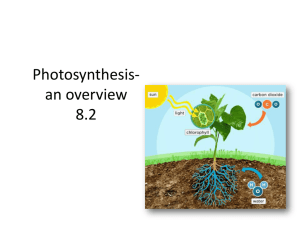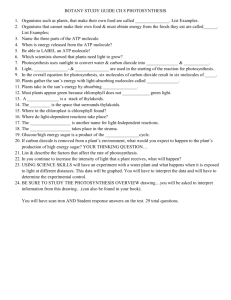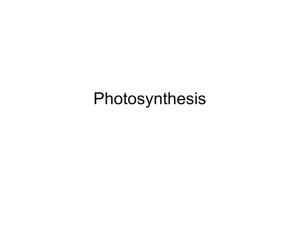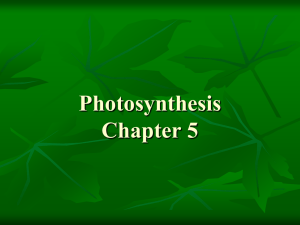Photosynthesis - SCHOOLinSITES
advertisement
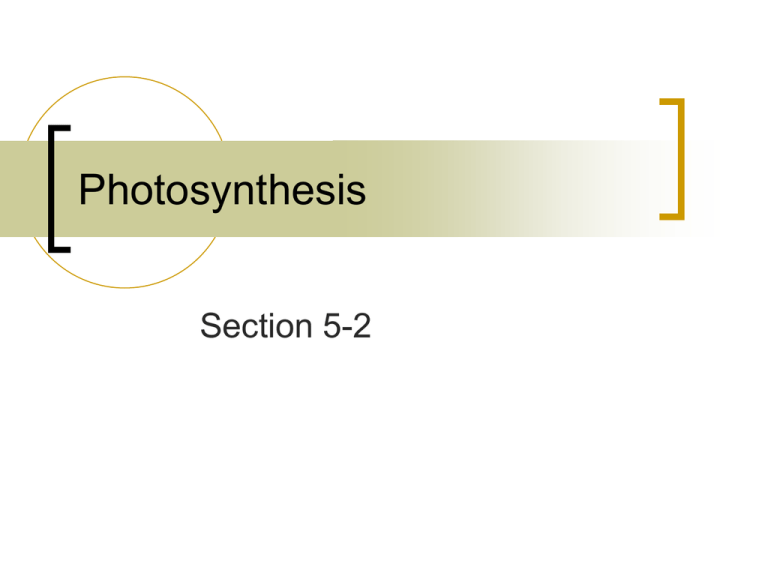
Photosynthesis Section 5-2 Photosynthetic Organisms Use the Energy in Sunlight Plants capture energy from sunlight Most of the time when you trace your food back to its origin, you end up with plants Plants, algae, and some bacteria capture about 1% of the energy in the sunlight that reaches Earth and convert it to chemical energy through the process of photosynthesis. Photosynthesis The process that provides energy for almost all life. Has three stages OVERALL CHEMICAL FORMULA 3 CO2 + 3 H2O → C3H6O3 + 3 O2 3 Stages of Photosynthesis Stage 1: Energy is captured from sunlight. Stage 2: Light energy is converted to chemical energy, which is temporarily stored in ATP and the energy carrier molecule NADPH. 3 Stages of Photosynthesis (con’t) Stage 3: The chemical energy stored in ATP and NADPH powers the formation of organic compounds, using CO2 Photosynthesis Occurs in the chloroplast of plant cells and algae and in the cell membrane of certain bacteria Plants use the organic compounds they make during photosynthesis to carry out their life processes. Stage One of Photosynthesis Light energy is absorbed These reactions are often called “light reactions” or “light-dependent reactions” because the absorption of light has to occur for the reactions to proceed Light energy is used to make energystoring compounds Stage One of Photosynthesis Pigments absorb different wavelengths of light. Pigments – light-absorbing substances that absorb only certain wavelengths Chlorophyll – primary pigment involved in photosynthesis. Absorbs mostly blue and red light. Reflects green and yellow. This is what makes a plant look green. Two types of chlorophyll – Chlorophyll A and Chlorophyll B Stage One of Photosynthesis Carotenoids – pigments that produce yellow and orange fall leaf colors. Produces the colors of many fruits, vegetables, and flowers. Absorb different wavelengths of light from those absorbed by chlorophyll Stage One of Photosynthesis By using chlorophyll and carotenoids, plants absorb more light energy during photosynthesis. Pigments are located in the chloroplasts of leaf cells. Thylakoids – clusters of pigments are embedded in the membranes of diskshaped structures called thylakoids Stage One of Photosynthesis When light strikes thylakoid, energy is transferred to electrons in chlorophyll and other pigments. This energy transfer causes electrons to jump to a higher energy level. These electrons are said to be “excited”. This is how plants first capture energy from sunlight. Stage One of Photosynthesis Excited electrons jump from chlorophyll molecules to other nearby molecules in the thylakoid membrane, where the electrons are used to power the second stage of photosynthesis. The excited electrons that leave chlorophyll molecules must be replaced by other electrons. Replacement electrons come from water molecules. The water molecules are split by an enzyme inside the thylakoid. Stage One of Photosynthesis Water molecules split – chlorophyll molecules take electrons from hydrogen atoms leaving hydrogen ions. Remaining oxygen atoms from disassembled water molecules combine to form oxygen gas. Stage Two of Photosynthesis In this stage, light is converted to chemical energy. Electron Transport Chains – series of molecules through which excited electrons are passed along a thylakoid membrane Excited electrons leave chlorophyll molecules are used to produce new molecules that temporarily store chemical energy, including ATP. Stage Two of Photosynthesis An excited electron jumps to a nearby molecule in a thylakoid membrane. The electron is passed through a series of molecules along the thylakoid membrane like a ball being passed down a line of people. Figure 5-8 p. 100 Stage Two of Photosynthesis – Action of Electron Transport Chains One type of ETC contains a protein that acts as a membrane pump. Excited electrons lose some of their energy as they pass through this protein. Energy lost by electrons used to pump hydrogen ions (H+) into the thylakoid. Recall… H+ produced when water molecules are split inside the thylakoid. Stage Two of Photosynthesis – Action of Electron Transport Chains H+ concentration higher on inside of thylakoid – produces concentration gradient across thylakoid membrane. Results in H+ having the tendency to diffuse back out of thylakoid down their concentration gradient Occurs through specialized carrier proteins – unique – function as enzyme and carrier protein/ion channel Stage Two of Photosynthesis – Action of Electron Transport Chains As H+ ions pass through channel portion – protein catalyzes a reaction in which a phosphate group is added to ADP – makes ATP. Movement of H+ across thylakoid membrane through carrier proteins provides energy to make ATP used to power the third stage of photosynthesis Stage Two of Photosynthesis – Action of Electron Transport Chains A second ETC provides energy used to make NADPH NADPH – an electron carrier that provides the high-energy electrons needed to make carbonhydrogen bonds in third stage of photosynthesis Excited electrons combine with H+ as well as an electron acceptor called NADP+ forming NADPH. Stage Two of Photosynthesis – Light-Dependent Reactions Pigment molecules in thylakoids of chloroplast absorb light energy. Electrons in pigments excited by light and move through ETC in thylakoid These electrons replaced by electrons from water molecules, which are split by an enzyme Oxygen atoms from water molecules combine to form oxygen gas H+ ions accumulate inside thylakoids, setting up a concentration gradient that provides the energy to make ATP and NADPH. Stage Three of Photosynthesis Carbon atoms from CO2 in the atmosphere are used to make organic compounds which store chemical energy. Carbon dioxide fixation – transfer of CO2 to organic compounds The reactions that “fix” CO2 often called “dark reactions” or light-independent reactions. Stage Three of Photosynthesis – Calvin Cycle Calvin Cycle – series of enzyme-assisted chemical reactions that produce a 3-carbon sugar. Figure 5-9 p. 102 STEP 1: Each molecule of CO2 is added to a 5-carbon compound by an enzyme STEP 2: The 6-carbon compound splits into 2 3-carbon compounds. Phosphate groups from ATP and electrons from NADPH are added to the 3-carbon compounds. Forms a 3-carbon sugar. Stage Three of Photosynthesis – Calvin Cycle STEP 3: 1 3-carbon sugar is used to make an organic compound STEP 4: The other 3-carbon sugar is used to regenerate the 3-carbon compound used in the beginning of the cycle The reactions are cyclic because they recycle the 5-carbon compound. 3 CO2 molecules must enter the cycle to make 3-carbon molecules (6 are made) Energy is supplied by 6NADPH and 9 ATP molecules. http://www.science.smith.edu/departm ents/Biology/Bio231/calvin.html http://www.phschool.com/science/biolo gy_place/biocoach/photosynth/calvin1. html http://www.emc.maricopa.edu/faculty/f arabee/BIOBK/BioBookPS.html Factors that Affect Photosynthesis Light – the rate of photosynthesis increases as light intensity increases until all pigments are being used. Then the rate of photosynthesis levels off. Most efficient within a range of temperatures. Like all metabolic processes, involves many enzymeassisted chemical reactions. Enzymes only react properly within certain temperature ranges. CO2 concentration – once certain concentration of CO2 is present, cannot proceed any faster.
